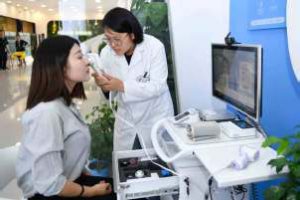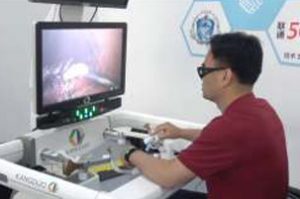The Health China 2030 plan is a comprehensive set of guidelines aimed at extending the services to all by the year 2030, and focuses on public health, the environment and food.
The People’s Republic of China (PRC) is a country in East Asia and the world’s most populous country, with a population of around 1.404 billion. Covering approximately 9,600,000 square kilometers (3,700,000 sq mi), it is the third or fourth largest country by total area. Governed by the Communist Party of China, the state exercises jurisdiction over 22 provinces, five autonomous regions, four direct-controlled municipalities (Beijing, Tianjin, Shanghai, and Chongqing), and the special administrative regions of Hong Kong and Macau.
Since the introduction of economic reforms in 1978, China’s economy has been one of the world’s fastest- growing with annual growth rates consistently above 6 percent. According to the World Bank, China’s GDP grew from $150 billion in 1978 to $12.24 trillion by 2017. According to official data, China’s GDP in 2018 was 90 trillion Yuan ($13.28 trillion). Since 2010, China has been the world’s second- largest economy by nominal GDP and since 2014, the largest economy in the world by purchasing power parity (PPP). China is also the world’s largest exporter and second-largest importer of goods.
Healthcare in China consists of both public and private medical institutions and insurance programs. About 95% of the population has at least basic health insurance coverage. Despite this, public health insurance generally only covers about half of medical costs, with the proportion lower for serious or chronic illnesses. The Chinese government is working on providing affordable basic healthcare to all residents by 2020. China has also become a major market for health-related multinational companies such as AstraZeneca, GlaxoSmithKline, Eli Lilly, and Merck entered the Chinese market and have experienced explosive growth. China has also become a growing hub for health care research and development.
Universal healthcare coverage
 The World Health Organization commended China for its health reform package, which provides a reference for universal healthcare coverage.
The World Health Organization commended China for its health reform package, which provides a reference for universal healthcare coverage.
China has been pushing for hierarchical diagnosis and treatment development while implementing reform in payment and other insurance. Now all public hospitals in China have removed their medicine mark-ups as the country continues its medical health reform.
Dr Margaret Chan, the former WHO director-general, noted that China puts people first in medical reform and cares about their interests. The nation’s success is worth spreading to other countries.
 The country has leapt to 48th place among 195 nations and regions from 60th in 2015, according to the report.
The country has leapt to 48th place among 195 nations and regions from 60th in 2015, according to the report.
Since 2017, China has made 53 cancer drugs affordable after two rounds of negotiations between the state medical insurance administration and pharmaceutical companies to include these drugs on the medical insurance list.
On top of that, the Chinese government officially cancelled tariffs on imported anticancer drugs from 1 May 2018. This year, China will start another round of negotiations, aiming to expand the medical insurance list to include another 128 drugs.
With the implementation of 5G and Internet Plus, China also achieved many firsts in distance medical care, providing the public with convenient access to medical services. In the future, online medical services are expected to become part of national medical insurance.
Healthcare and innovation
China’s medical and healthcare services have seen profound upgrades in recent years. An efficient drug regulatory system, policies focusing on dis advantaged people, steady progress of Traditional Chinese Medicine (TCM) and, most importantly, embracing cutting-edge technologies, are behind this improvement.
Progressive growth throughout the last seven decades has brought facilities to far-off counties at times on par with those offered in top-tier metropolitan cities. The biggest role in achieving this is being played by high technology advances.
Incorporation of 5G in hospitals is in full swing. This high-speed communication technology allows seamless synchronized actions of doctors who are hundreds of miles apart. Using robots, they can perform tele operations with minimally invasive procedures; consequently reducing the time patients have to stay in hospital. Another innovative use of live broadcasts of surgical operations via 5G is providing new learning opportunities for young doctors.
From established corporations to fledgling startups, all recognize the potential for digital technologies, such as tele health and artificial intelligence, to all eviate China’ s over stretched healthcare professionals and help provide better care.
In the process, hospitals are amassing an extensive amount of data. Artificial Intelligence (AI), with its ability to analyze large volumes of information, helps doctors in their diagnosis and making decisions. AI can also screen X-rays and predict a course of treatment combined with study of medical records.
Both local and foreign AI technologies are being utilized in China. To name a few, Shenzhen-based Tencent Holding is employing solutions that scan gastroscopy images to diagnose esophageal cancer at a preliminary stage with over 90 percent accuracy. Meanwhile, Microsoft, the American tech giant, has developed a system in collaboration with China’s Airdoc to diagnose diabetes.
In fact, the 2019 Future Health Index from Philips, which surveyed healthcare professionals in 15 countries around the world, shows that China is leading the way in adoption of digital health technology.
However, global health technology innovators looking to China face barriers – including a medical and digital infrastructure that is vastly different from other countries, unique regulatory demands, and a lack of affordability of existing solutions for more widespread use in rural or impoverished regions.
In 2018, Philips struck a partnership with Digital Health China, the largest provider of cloud-based healthcare services in China, to jointly launch a tele- radiology platform. The platform allows radiological images and associated patient information to be remotely viewed and analysed by clinical experts anywhere in the country, so that patients can receive treatment via their local healthcare facility, wherever they are. Unlike traditional business models, which require larger investments from hospitals upfront, a pay-per-use arrangement makes the platform affordable even for smaller hospitals.
These scientific breakthroughs create a smart healthcare ecosystem, offering convenience to patients and medical practitioners.
Healthcare China 2030
Apart from dispensing facilities, the government has been implementing a stream of supportive policies to improve the overall healthcare structure.
Incorporation of 5G in hospitals is in full swing. This high-speed communication technology allows seamless synchronized actions of doctors who are hundreds of miles apart. Using robots, they can perform teleoperations with minimally invasive procedures; consequently reducing the time patients have to stay in hospital. Another innovative use of live broadcasts of surgical operations via 5G is providing new learning opportunities for young doctors.
The Health China 2030 plan is a comprehensive set of guidelines aimed at extending the services to all by the year 2030, and focuses on public health, the environment and food.
The plan has set some promising goals, which include increasing life expectancy to 79 years and creating a healthcare industry worth 16 trillion yuan. This will be achieved by attracting private and foreign capital, expansion of government investment and improvement of medical institutions.
Measures are also being taken, in parallel, to increase convenience for underprivileged areas.
 By the end of 2018, every impoverished county had at least one public hospital, while about 95 percent of townships had at least one general practitioner. In the meanwhile, financing to village health centers is being expanded and they are also receiving technical support from large hospitals. As a result, the poor, who earlier didn’t seek medical help until their condition became unbearable, are now being cured at an early stage.
By the end of 2018, every impoverished county had at least one public hospital, while about 95 percent of townships had at least one general practitioner. In the meanwhile, financing to village health centers is being expanded and they are also receiving technical support from large hospitals. As a result, the poor, who earlier didn’t seek medical help until their condition became unbearable, are now being cured at an early stage.
In June 2019, the State Council issued a series of directives to guide the direction of healthcare reforms. Alongside the development of new drugs, production of generic drugs is encouraged and a list of urgently needed ones has been released for the private sector to take up.
A crucial challenge addressed by these directives is China’s ageing population. An improved healthcare system is being developed for senior citizens whose medical requirements continue to increase.
The State Council also outlined innovation in TCM since it is a major source of fulfilling the demand for health services. Authorities are promoting its integration with Western medicine and the latest guidelines call upon bolstering these efforts.
The government is making endeavors to ensure TCM develops through hospital-led, county-based and close-knit communities, according to a document released by the National Health Commission last month.
Medical advancements
Benefits of China’s medical advancements are spreading far beyond its borders. Chinese biotech startups are expanding their presence in Silicon Valley and bringing research opportunities to the United States. Besides, a myriad of devices developed by Chinese brands are being applied in hospitals all across the Western world.
In developing countries, China is providing a remarkable support to public health. During last year’s Forum on China-Africa Cooperation, China pledged to upgrade 50 medical aid programs for Africa and has been regularly sending medical missions overseas, efforts that are appreciated by international bodies.
The process of improving medical services is a continuous one. As China moves ahead in its high- quality development, authorities are making amenities available to more and more people. With the adoption of latest technologies, it is expected that the best healthcare will continue to be extended even to the remotest areas.














